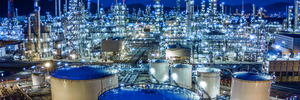Positive displacement pump
Positive displacement pumps are hydrostatic work machines. They convey a defined volume that depends on the motor speed but is almost independent of the pressure. Despite varying design principles, these positive displacement pumps often handle very similar pumping tasks.
The most common types of positive displacement pumps are gear pumps, rotary lobe pumps, circumferantial piston pumps and vane pumps. Most of these pumps can be designed to handle a variety of pumping jobs.
Rotary lobe pumps are frequently used and capable of pumping media with significantly larger particles than other types of positive displacement pumps. On the other hand, the distances between the displacers are larger, so that the performance of these pumps declines with decreasing viscosity. They are not as robust as for example circumferantial piston pumps or twin-screw pumps, and their suction properties also fall short of the properties of the displacement pump types described above. As a result, some design principles prove better than others for certain tasks.
In contrast to centrifugal pumps, the strengths of positive displacement pumps are in their ability to move viscous pumped media. They are also the pump of choice when the product needs be conveyed from A to B particularly gently. Gentle pumping is essential in the food and beverage industry, but also in the manufacture of pharmaceutical products and cosmetics, as is pump construction in accordance with the principles of hygienic design.
Positive displacement pumps for these industries or applications are therefore made of stainless steel, free of dead spaces and easy to clean. Any product residues remaining in positive displacement pumps or other components after cleaning become a problem, as they constitute a potential risk of contamination of subsequent product batches and serve as a breeding ground for microorganisms.
To avoid these problems, hygienic pumps should always have a surface finish of Ra < 0.8. Where seals are used, unwanted gaps are also an important issue. A key principle of hygienic design is to dispense with the use of seals entirely where possible. In practice, however, this simply cannot be done in most production facilities in the food and pharmaceutical industries.
Seals separate the product space from the outside world. The effect of seals must be reliable and verifiable under all process conditions. Seal design is therefore also subject to stringent hygiene criteria.
For design reasons, two types of seals are usually used in positive displacement pumps: mechanical seals and O-rings. For use in the production of food, beverages, pharmaceuticals and cosmetics, FDA-compliant plastic materials such as EPDM or FKM materials are generally used for O-rings. Depending on the application, single-acting or double-acting mechanical seals are used.
In hygienic applications, positive displacement pumps play a crucial role. They demonstrate their advantages in practically all market segments, especially when conveying viscous media or media with lumpy additions.










